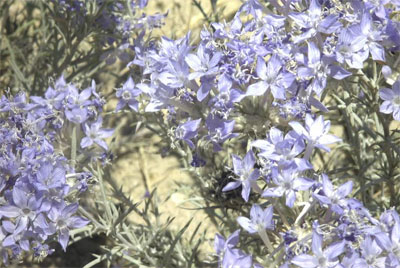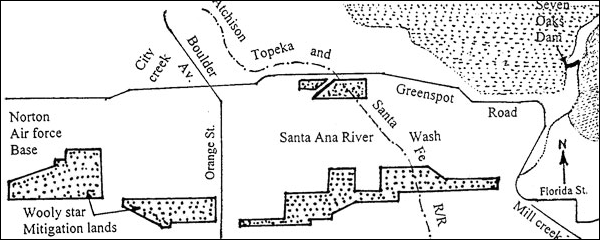Santa Ana River Woolly Star (Eriastrum densifolium sanctorum)

What is the Santa Ana River Woolly Star?
Biologists call it the Eriastrum densifolium sanctorum. The Santa Ana River woolly star is a wild flowering plant. It belongs to the Riversidian Alluvial Fan Sage Scrub community that dominates the Santa Ana River flood plain.
With stems growing 10 to 30 inches tall from a woody base, the plant has a white woolly color with irregularly divided leaves along its stem and blue-lavendar flowers forming slender tubes that radiate open at the top. It blooms every year from late May to mid-August, with peak flowering in June.
Why is it in danger?
The Army Corps of Engineers and the three flood control districts (sponsors) are now building the much-needed Santa Ana River Mainstem Project to protect over three million people from massive flooding in San Bernardino, Riverside, and Orange Counties. A key feature of the project is the Seven Oaks Dam in upper Santa Ana Canyon – about two miles upstream from where the woolly star grows. When completed in 1999, the dam will be more than double the current level of flood protection. In doing so, it will reduce the amount of sand that flows with water in the river and settles in the streambed below.
The woolly star depends on new sand deposits for its survival. The plant first sprouts in this new sand. Since each plant lives an average of only 5 years, seed reproduction by pollination is the basic way the new plants take root in “older” sand.
Over the long term, without new sand deposits, all Santa Ana woolly stars would die. Fortunately, the Santa Ana Project includes a federal and local government commitment to preserving the woolly star.
What is being done to help?
The flood control districts have permanently reserved 764 acres in the Santa Ana River flood plain where the woolly star grows today(see below). The San Bernardino County Flood Control District will manage the “reserve”.

It is more than just a permanent home for the plant. It is a laboratory.
Over the next 10 years, biologists will conduct research to learn more about both the plant and the pollinators on which it depends – seeking answers to such questions as:
- Where and when do the pollinating hummingbirds, bees, and flies breed, nest, and feed?
- How do they depend on the woolly star?
- How does the woolly star depend on them?
- How does the woolly star change at each stage of its growth?
- How many plants must grow in a given area to ensure the species’ survival?
The biologists will observe how well nature is caring for the woolly star. They will monitor both new sand deposits in the flood plain and the plant’s presence, abundance, and distribution.
They will experiment with different methods to duplicate how nature rejuvenates habitat for the woolly star. This will enable them to apply the most effective methods (including seed planting) whenever the plant’s population drops below the minimum number considered necessary for survival.
As you can see, the Corps and the three flood control districts have made a significant commitment to the woolly star.
What can you do to help?
You can respect the need to restrict the public access to the only home that the woolly star has. The managers are posting the signs around the area to tell you what you can’t do. Off road vehicle motoring, bicycling, and horseback riding are expressly prohibited because they kill the plant outright, compact the soil, and form the artificial depressions that speed up the silt accumulation that shortens the habitat’s life. The managers will regularly patrol the area to reinforce the message.
For More Information Please Contact:
David Lovell
(909) 387-7964